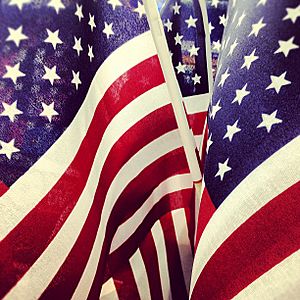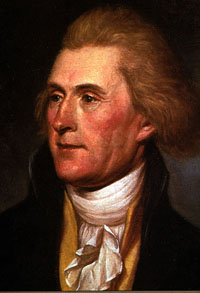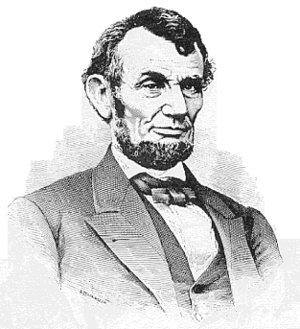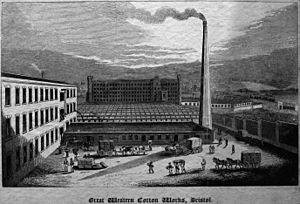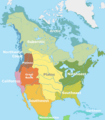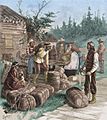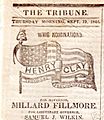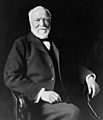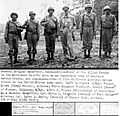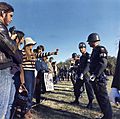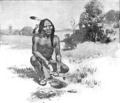The United States in the 19th century facts for kids
The United States was a country that grew a lot in the 19th century. This period lasted from 1801 to 1900. During this time, the U.S. expanded from 17 states to 45 states. New states like Utah, Illinois, and Mississippi joined the country.
The United States had 22 presidents during the 19th century. The Industrial Revolution was also happening, changing how things were made. The first skyscraper was built, and the White House became the official home for the president. There was a war with Great Britain in 1812. Later, in 1866, Alfred Nobel invented dynamite. The sport of Basketball was also created. In 1829, William Austin Burt patented a machine called the "Typographer", which many see as the first typewriter. The 19th century also saw big disasters like the Great Chicago Fire and the Great September Gale of 1815 hitting New York City.
Contents
Leaders of the 19th Century United States
The United States had 22 presidents in the 19th Century. Thomas Jefferson was the third President of the United States. He was the first president elected in the 19th century. The last president of this century was William McKinley. McKinley started his presidency in 1897 and finished in 1901. All these presidents lived in the White House during their time in office.
Thomas Jefferson: A Key Early President
Thomas Jefferson was born on April 13, 1743. His parents were Jane Randolph Jefferson and Peter Jefferson. He had many brothers and sisters. He was a member of the Democratic-Republican Party. He served as president from 1801 to 1809. He passed away on July 5, 1826, and was buried at Monticello.
Abraham Lincoln: A President During Tough Times
Abraham Lincoln was born on February 12, 1809. This was when Thomas Jefferson was still president. He was the second child of Thomas and Nancy Lincoln. He was born in Kentucky. Lincoln married Mary Todd and they had four children. Lincoln belonged to the Whig Party and later the Republican Party. He was sadly killed while he was still president.
Martin Van Buren: A Unique President
Martin van Buren was born on December 5, 1782, in Kinderhook, New York. His parents were Abraham and Maria van Buren. His family had come to the United States from the city of Buren in 1631. Martin is the only president who spoke English as a second language. His first language was Dutch. His political party was the Free Soil Party. Martin was president from 1837 to 1841. He died on July 24, 1862.
James Monroe: From Virginia to the White House
James Monroe was born on April 28, 1758, in Virginia. His parents were Spence and Elizabeth Monroe. James Monroe married Elizabeth Kortright. They had three children. He died on July 4, 1831, in New York City, at 73 years old.
The Industrial Revolution: Changing America
The Industrial Revolution was a time when the United States changed from a farming country to one with many factories. This change took more than 100 years. It started in England around 1750 and came to the United States about 50 years later. This was because America had a lot of land for farming, but not enough workers for factories. Also, industrial machines were very expensive.
Samuel Slater: Bringing Factories to America
The Industrial Revolution in America really began with Samuel Slater. He built the first industrial mill in the United States around 1790. His cotton mill was similar to British mills. This new mill greatly increased how fast cotton thread could be spun into yarn.
Another reason for the fast-changing economy was new ways to organize work. These new methods helped speed up how products were made. This was very important for the shoe and boot industry. Before, most products were made by hand.
The most important change was the "Factory System." This system allowed products to be made on a very large scale. Factories needed many people to operate the machines. A group of business owners called the Boston Associates hired thousands of young farm girls from New England to work in these new factories.
Lowell: A Town Built on Mills
One of the most famous mill towns was Lowell, Massachusetts, which opened in 1823. Using female factory workers had benefits for both the employers and the workers. The Boston Associates liked hiring young girls because they could pay them less than men. These female factory workers were often called "Lowell Girls," named after the town.
Images for kids
-
This map shows the approximate location of the ice-free corridor and specific Paleoindian sites (Clovis theory).
-
The Cultural areas of pre-Columbian North America, according to Alfred Kroeber.
-
Join, or Die: This 1756 political cartoon by Benjamin Franklin urged the colonies to join together during the French and Indian War.
-
Washington's surprise crossing of the Delaware River in December 1776 was a major comeback after the loss of New York City; his army defeated the British in two battles and recaptured New Jersey.
-
John Trumbull's Declaration of Independence (1819)
-
George Washington legacy remains among the two or three greatest in American history, as Commander-in-Chief of the Continental Army, hero of the Revolution, and the first President of the United States.
-
Territorial expansion; Louisiana Purchase in white.
-
Oliver Hazard Perry's message to William Henry Harrison after the Battle of Lake Erie began with what would become one of the most famous sentences in American military history: "We have met the enemy and they are ours". This 1865 painting by William H. Powell shows Perry transferring to a different ship during the battle.
-
Settlers crossing the Plains of Nebraska.
-
The Indian Removal Act resulted in the transplantation of several Native American tribes and the Trail of Tears.
-
Horace Greeley's New York Tribune—the leading Whig paper—endorsed Clay for President and Fillmore for Governor, 1844.
-
The California Gold Rush news of gold brought some 300,000 people to California from the rest of the United States and abroad.
-
The American occupation of Mexico City in 1848
-
Lincoln with Allan Pinkerton and Major General John Alexander McClernand at the Battle of Antietam.
-
Freedmen voting in New Orleans, 1867.
-
The completion of the Transcontinental Railroad (1869) at First Transcontinental Railroad, by Andrew J. Russell
-
Scottish immigrant Andrew Carnegie led the enormous expansion of the American steel industry.
-
Mulberry Street, along which Manhattan's Little Italy is centered. Lower East Side, circa 1900. Almost 97% of residents of the 10 largest American cities of 1900 were non-Hispanic whites.
-
Charlotte Perkins Gilman (pictured) wrote these articles about feminism for the Atlanta Constitution, published on December 10, 1916.
-
Prohibition agents destroying barrels of alcohol in Chicago, 1921.
-
Money supply decreased a lot between Black Tuesday and the Bank Holiday in March 1933 when there were massive bank runs across the United States.
-
Dorothea Lange's Migrant Mother depicts destitute pea pickers in California, centering on Florence Owens Thompson, a mother of seven, age 32, in Nipomo, California, March 1936.
-
General Douglas MacArthur meeting Navajo, Pima, Pawnee and other Native American troops. Navajo served as code talkers for the military in the Pacific. The code they made, although cryptologically very simple, was never cracked by the Japanese.
-
Cuban Missile Crisis a U-2 reconnaissance photograph of Cuba, showing Soviet nuclear missiles, their transports and tents for fueling and maintenance.
-
President Kennedy's Civil Rights Address, June 11, 1963.
-
United States Navy F-4 Phantom II shadows a Soviet Tu-95 Bear D aircraft in the early 1970s
-
Richard Nixon departs
-
Ronald Reagan at the Brandenburg Gate challenges Soviet premier Mikhail Gorbachev to tear down the Berlin Wall in 1987, shortly before the end of the Cold War.
-
Clinton, Yitzhak Rabin and Yasser Arafat during the Oslo Accords on September 13, 1993.
-
George W. Bush addressed the General Assembly of the United Nations on September 12, 2002 to outline the complaints of the United States government against the Iraqi government.
-
Headquarters of the Lehman Brothers, who filed for bankruptcy in September 2008 at the height of the U.S. financial crisis.
-
"What happened to 'All Lives Matter'?", a sign at a protest against Donald Trump
-
Squanto known for having been an early liaison between the native populations in Southern New England and the Mayflower settlers, who made their settlement at the site of Squanto's former summer village.
-
An 1846 painting of the 1773 Boston Tea Party.
-
The population density in the American Colonies in 1775.
-
Grave Creek Mound, located in Moundsville, West Virginia, is one of the largest conical mounds in the United States. It was built by the Adena culture.
-
Monks Mound of Cahokia (UNESCO World Heritage Site) in summer. The concrete staircase follows the approximate course of the ancient wooden stairs.
-
An artistic recreation of The Kincaid Site from the prehistoric Mississippian culture as it may have looked at its peak 1050–1400 CE.
-
Cliff Palace, Mesa Verde National Park, a UNESCO World Heritage Site.
-
Women surrounded by posters in English and Yiddish supporting Franklin D. Roosevelt, Herbert H. Lehman, and the American Labor Party teach other women how to vote, 1936.


